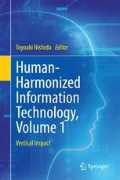Abstract
The JST-CREST research area on the creation of human-harmonized information technology for a convivial society aims for the establishment of basic technologies to achieve harmony between human beings and the information environment by integrating element technologies encompassing real-space communication, human interfaces, and media processing. It promotes a trans-disciplinary approach featuring (1) recognition and comprehension of human behaviors and real-space contexts by utilizing sensor networks and ubiquitous computing, (2) technologies for facilitating man-machine communication by utilizing robots and ubiquitous networks, and (3) content technologies for analyzing, mining, integrating, and structuring multimedia data including those in text, voice, music, and images. It ranges from scientific research on cognitive aspects of human-harmonized information processes to social implementation that may lead to breakthroughs in the harmonious interactions of human and information environments. This chapter presents the underlying philosophy, background, core concepts, and major results obtained from the first half of projects that were selected to pursue new findings in this research area.
Access this chapter
Tax calculation will be finalised at checkout
Purchases are for personal use only
Notes
- 1.
- 2.
Based on the exchange rate: 1 EUR = 130 JPN.
- 3.
- 4.
- 5.
p. 28 in [10].
- 6.
- 7.
- 8.
- 9.
- 10.
References
K. Aizawa, FoodLog: multimedia food recording tools for diverse applications (2016). (in this volume)
T. Ando, Losing Battle After Battle (The University of Tokyo Press, 2001). (in Japanese)
Nick Bostrom, Superintelligence: Paths, Dangers Strategies (Oxford University Press, Oxford, 2014)
E. Brynjolfsson, A. McAfee, Race Against the Machine (Digital Frontier Press, Lexington, MA, 2011)
E. Brynjolfsson, A. McAfee, The Second Machine Age (W. W. Norton & Company, New York, 2014)
R. Caillois, Les jeux et les hommes: Le masque et le vertige. Gallimard, 1958. (translated by Meyer Barash and printed from The Free Press of Glencoe, Inc. in 1961)
N. Carr, The Glass Cage: Automation and Us (W. W. Norton & Company, 2014)
T. Cowen, Average is Over: Powering America beyond the Age of the Great Stagnation (Dutton, 2013)
L. Gratton, The Shift: The Future of Work is Already Here (Harper Collins Pub., 2011)
J. Huizinga, Homo Ludens: A Study of the Play Element in Culture (Beacon Press, New York, 1955). (Originally published in 1938)
H. Ishiguro, Transmitting human presence through portable teleoperated androids—a minimal design approach (2016). (in this volume)
M. Ishikawa, I. Ishii, Y. Sakaguchi, M. Shimojo, H. Shinoda, H. Yamamoto, T. Komuro, H. Oku, Y. Nakajima, Y. Watanabe, Dynamic information space based on high-speed sensor technology (2016). (in this volume)
M. Kashino, S. Shimojo, K. Watanabe, Critical roles of implicit interpersonal information in communication (2016). (in this volume)
T. Kawahara, Smart Posterboard: Multi-modal sensing and analysis of poster conversations (2016). (in this volume)
Y. Koike, Elucidation of perceptual illusion and development of sense-centered human interface (2016) (in this volume)
C.B. Macpherson. The Political Theory of Possessive Individualism—Hobbes to Locke (Oxford University Press, 1962)
A.H. Maslow, Motivation and Personality (Addison-Wesley Educational Publishers Inc., 1954)
T. Nishida, Toward mutual dependency between empathy and technology. AI SOC 28(3), 277–287 (2013)
T. Nishida, Information and communication technology for augmenting human and society potential: The role of artificial intelligence. J. Inf. Process. Manage. 57(8), 517–530 (2014). (in Japanese)
T. Nishida, R. Nishida, Socializing artifacts as a half mirror of the mind. AI SOC 21(4), 549–566 (2007)
D.A. Norman, The Invisible Computer: Why Good Products Can Fail, the Personal Computer Is So Complex, and Information Appliances Are the Solution (The MIT Press, 1998)
J. Rawls. A Theory of Justice (Oxford University Press, 1999)
J. Rifkin, The End of Work, The Decline of the Global Labor Force and the Dawn of the Post-Market Era (G. P. Putnams Sons, 1995)
Y. Sato, Y. Sugano, A. Sugimoto, Y. Kuno, H. Koike, Sensing and controlling human gaze in daily living space for human-harmonized information environments (2016). (in this volume)
S. Tachi, Haptic media: construction and utilization of haptic virtual reality and haptic telexistence (2016). (in this volume)
K. Takeda, Modeling and detecting exceesive trust from behavior signals: overview of research project and results (2016). (in this volume)
Sherry Turkle, Alone Together: Why we expect more from technology and less from each other (Basic Books, New York, 2011)
E. Zhunda, Youtube Millionaire—Every Million view Channel Secrets Revealed (English Edition) (Edgar Zhunda, 2015)
Author information
Authors and Affiliations
Corresponding author
Editor information
Editors and Affiliations
Rights and permissions
Copyright information
© 2016 Springer Japan
About this chapter
Cite this chapter
Nishida, T. (2016). Introduction to Human-Harmonized Information Technology. In: Nishida, T. (eds) Human-Harmonized Information Technology, Volume 1. Springer, Tokyo. https://doi.org/10.1007/978-4-431-55867-5_1
Download citation
DOI: https://doi.org/10.1007/978-4-431-55867-5_1
Published:
Publisher Name: Springer, Tokyo
Print ISBN: 978-4-431-55865-1
Online ISBN: 978-4-431-55867-5
eBook Packages: Computer ScienceComputer Science (R0)

